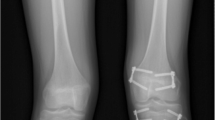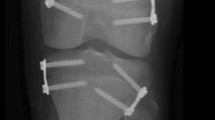Abstract
Background
Although eight-plates have been shown to be effective in correcting angular deformities of the knee, the literature is scarce regarding the efficiency of this method in treatment of children with LLD.
Objectives
The aim of this study was to determine the efficiency, rates of correction and complications of epiphysiodesis using eight-plate in the management of children with leg length discrepancy (LLD).
Methods
Eleven consecutive patients with LLD (7 boys, median age = 9, age range 6–11 years) who were treated by temporary epiphysiodesis using eight-plates were retrospectively reviewed and included in the study. The main indication for temporary epiphysiodesis was an LLD between 2 and 5 cm in all patients. LLD and lower limb alignment were examined on lower extremity weight-bearing radiography preoperatively and at skeletal maturity. Longitudinal correction rate was calculated. The final LLD was categorized as ‘’good result’’ (final LLD < 1.5 cm), ‘’fair result’’ (1.5–2 cm), and ‘’poor result’’ (> 2 cm).
Results
The mean treatment period with the eight-plate was 44 (min to max = 32–72) months, and the mean follow-up from the index surgery to the final follow-up was 62 (min to max = 39–106) months. The mean LLD was significantly reduced from 39 (range 25–50) mm preoperatively to 22.40 (range 6–55) mm postoperatively (p = 0.006). The mean longitudinal correction rate was found to be 0.48 mm/mo. Radiographic evidence of lower limb deformity in frontal and sagittal planes was determined in neither preoperative nor postoperative deformity analysis. No major complications were recorded.
Conclusion
For the management of children with LLD of 2–5 cm, temporary hemiepiphysiodesis using the eight-plate seems to be an effective treatment with low complication rates.



Similar content being viewed by others
References
Gaumétou, E., Mallet, C., Souchet, P., Mazda, K., & Ilharreborde, B. (2016). Poor efficiency of eight-plates in the treatment of lower limb discrepancy. Journal of Pediatric Orthopedics, 36, 715–719.
Bayhan, I. A., Karatas, A. F., Rogers, K. J., Bowen, J. R., & Thacker, M. M. (2017). Comparing percutaneous physeal epiphysiodesis and eight-plate epiphysiodesis for the treatment of limb length discrepancy. Journal of Pediatric Orthopedics, 37, 323–327.
Ferrick, M. R., Birch, J. G., & Albright, M. (2004). Correction of non-Blount’s angular knee deformity by permanent hemiepiphyseodesis. Journal of Pediatric Orthopedics, 24, 397–402.
Lykissas, M. G., Jain, V. V., Manickam, V., Nathan, S., Eismann, E. A., & McCarthy, J. J. (2013). Guided growth for the treatment of limb length discrepancy: A comparative study of the three most commonly used surgical techniques. Journal of Pediatric Orthopedics. Part B, 22, 311–317.
Kumar, S., & Sonanis, S. (2018). Growth modulation for coronal deformity correction by using eight plates—systematic review. Journal of Orthopaedics, 15, 168–172.
Stevens, P. M. (2007). Guided growth for angular correction: A preliminary series using a tension band plate. Journal of Pediatric Orthopedics, 27, 253–259.
Boero, S., Michelis, M. B., & Riganti, S. (2011). Use of the eight-plate for angular correction of knee deformities due to idiopathic and pathologic physis: Initiating treatment according to etiology. Journal of Children’s Orthopaedics, 5, 209–216.
Zajonz, D., Schumann, E., Wojan, M., Kübler, F. B., Josten, C., Bühligen, U., & Heyde, C. E. (2017). Treatment of genu valgum in children by means of temporary hemiepiphysiodesis using eight-plates: Short-term findings. BMC Musculoskeletal Disorders, 18, 456.
Özdemir, E., Emet, A., Ramazanov, R., & Yılmaz, G. (2021). Correction of coronal plane deformities around knee in children with two-hole tension band plates. Jt Dis Relat Surg, 32, 177–184.
Anderson, M., Green, W. T., & Messner, M. B. (1978). The classic: Growth and predictions of growth in the lower extremities. Clinical Orthopaedics and Related Research. https://doi.org/10.1097/00003086-197810000-00002
Paley, D., Bhave, A., Herzenberg, J. E., & Bowen, J. R. (2000). Multiplier method for predicting limb-length discrepancy. Journal of Bone and Joint Surgery. American Volume, 82, 1432.
Sabharwal, S., & Kumar, A. (2008). Methods for assessing leg length discrepancy. Clinical Orthopaedics and Related Research, 466, 2910–2922.
Kemnitz, S., Moens, P., & Fabry, G. (2003). Percutaneous epiphysiodesis for leg length discrepancy. Journal of Pediatric Orthopedics. Part B, 12, 69–71.
Paley, D., Herzenberg, J. E., Tetsworth, K., McKie, J., & Bhave, A. (1994). Deformity planning for frontal and sagittal plane corrective osteotomies. Orthopedic Clinics of North America, 25, 425–466.
Siedhoff, M., Ridderbusch, K., Breyer, S., Stücker, R., & Rupprecht, M. (2014). Temporary epiphyseodesis for limb-length discrepancy: 8-to 15-year follow-up of 34 children. Acta Orthopaedica, 85, 626–632.
Nouth, F., & Kuo, L. A. (2004). Percutaneous epiphysiodesis using transphyseal screws (PETS): Prospective case study and review. Journal of Pediatric Orthopedics, 24, 721–725.
Stewart, D., Cheema, A., & Szalay, E. A. (2013). Dual 8-plate technique is not as effective as ablation for epiphysiodesis about the knee. Journal of Pediatric Orthopedics, 33, 843–846.
Makarov, M. R., et al. (2018). Complications associated with epiphysiodesis for management of leg length discrepancy. Journal of Pediatric Orthopedics, 38, 370–374.
Lauge-Pedersen, H., & Hägglund, G. (2013). Eight plate should not be used for treating leg length discrepancy. Journal of Children’s Orthopaedics, 7, 285–288.
Borbas, P., Agten, C. A., Rosskopf, A. B., Hingsammer, A., Eid, K., & Ramseier, L. E. (2019). Guided growth with tension band plate or definitive epiphysiodesis for treatment of limb length discrepancy? Journal of Orthopaedic Surgery and Research, 14, 1–7.
Author information
Authors and Affiliations
Contributions
Each author listed above contributed significantly to, and is willing to take public responsibility for, one or more aspects of the study. All authors participated in the study design and analysis and interpretation of the data. All authors were actively involved in drafting and the critical revision of the manuscript and have given final approval of the version to be submitted. YS: design of the study, analysis and interpretation of data, drafting and critical revision of the manuscript. MD: analysis of data, drafting and critical revision of the manuscript. MAY: design of the study, drafting and critical revision of the manuscript. FB: design of the study, drafting and critical revision of the manuscript. AŞ: drafting and critical revision of the manuscript. CS: design of the study, drafting and critical revision of the manuscript.
Corresponding author
Ethics declarations
Conflict of Interest
Mehmet Demirel, Yavuz Sağlam, Ahmet M. Yıldırım, Fuat Bilgili, Ali Şeker, and Cengiz Şen declare that they have no conflict of interest. Each author certifies that he or she has no commercial associations that might pose a conflict of interest in connection with the submitted article.
Ethical Approval
Approval of the institutional board review of the current study was obtained from the Istanbul University, Istanbul Faculty of Medicine in 10. 05. 2019. The study was performed in accordance with the ethical standards in the 1964 Declaration of Helsinki. All the study was performed at İstanbul University, İstanbul Faculty of Medicine.
Consent for Publication
This study has not been published elsewhere before. It is not accepted for publication and under consideration by another publication.
Additional information
Publisher's Note
Springer Nature remains neutral with regard to jurisdictional claims in published maps and institutional affiliations.
Rights and permissions
About this article
Cite this article
Demirel, M., Sağlam, Y., Yıldırım, A.M. et al. Temporary Epiphysiodesis Using the Eight-Plate in the Management of Children with Leg Length Discrepancy: A Retrospective Case Series. JOIO 56, 874–882 (2022). https://doi.org/10.1007/s43465-021-00599-9
Received:
Accepted:
Published:
Issue Date:
DOI: https://doi.org/10.1007/s43465-021-00599-9




